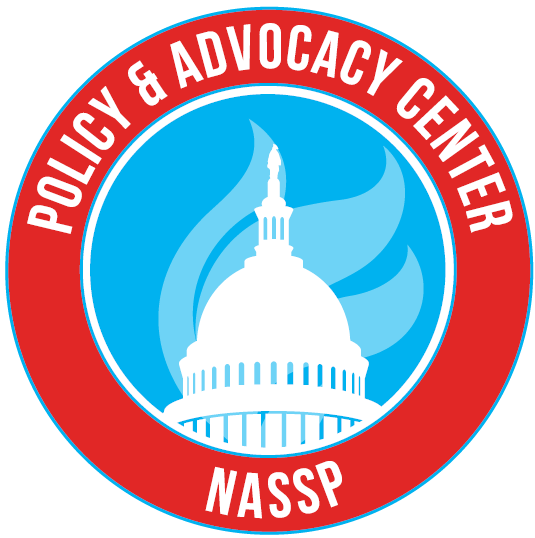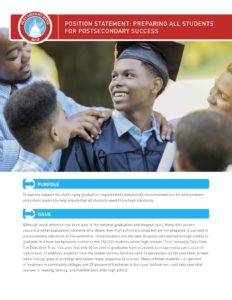To express support for challenging graduation requirements and provide recommendations for federal, state, and local policymakers to help schools ensure that all students meet those high standards.
Although much attention has been paid to the national graduation and dropout rates, those discussions obscure another population: students who obtain their high school diplomas but are not prepared to succeed in postsecondary education or the workforce. Those students are the near dropouts who earned enough credits to graduate, but have backgrounds similar to the 1.2 million students whom high schools “lose” annually. Data from the National Education Longitudinal Study indicates that only 40 percent of graduates have accessed a college-ready curriculum in high school. In addition, students from the lowest-income families were 14 percentage points less likely to have taken college-prep or a college and career ready sequence of courses. Many of those students—42% of freshmen in community colleges and 20% of freshman in four-year institutions—will take remedial courses in reading, writing, and mathematics after high school.

The most recent version of the Elementary and Secondary Education Act, which was passed by Congress in 2015, requires states to adopt challenging academic content standards for mathematics, reading or language arts, and science. The law specifies that these standards must be aligned with entrance requirements for credit-bearing coursework in the state’s public higher education system and relevant state career and technical education standards. But raising academic standards alone is not enough to ensure that all students, especially low-income and minority students, will graduate from high school and succeed in postsecondary education and the workforce. Supports must be in place to help schools ensure that all students achieve this goal.
Guiding Principles
NASSP believes that all students should graduate from high school with the skills to help them succeed in postsecondary education and the workplace.
NASSP is a partner of the Pathways to College Network, which advances college opportunity by promoting the use of research-based policies and practices, the development of new research that is both rigorous and actionable, and the alignment of efforts across middle school, high school, and higher education in order to improve college access and success for underserved students.
NASSP released Policy Recommendations for College and Career Ready Standards in 2014 that acknowledged the importance of principal leadership in ensuring the successful implementation of college and career ready standards in their schools.
To help principals improve and maintain high-quality learning environments in schools of all kinds, Building Ranks incorporates the essential leadership skills that can influence the two domains—culture and learning—that contribute to a highly effective school environment capable of preparing the whole child for success in a global community.
Recommendations
Recommendations for Federal Policymakers
The federal government should create a separate funding stream to improve student achievement at the middle level and high school, reduce the number of high school dropouts, and ensure that all students graduate from high school with the skills they need to succeed in college and the workforce.
Congress should fully fund the Student Support and Academic Enrichment Grants under Title IV, Part A of the Elementary and Secondary Education Act to help K–12 schools provide students access to advanced courses and college and career counseling.
Recommendations for State and District Policymakers
States should require colleges and universities to set clear and understandable academic expectations for incoming students and make those recommendations readily available to the public.
States should align their middle level promotion standards, high school graduation requirements, instruction, and assessments with college and career ready standards, as well as the expectations of colleges and employers.
States should make every effort to increase the maximum compulsory age for school attendance to 18 for all students who have not already completed the requirements for a high school diploma.
States should align principal and teacher preparation programs and professional development with higher graduation requirements.
States should offer incentives to help school districts attract and retain the most effective principals and teachers in the schools with the highest need.
States and districts should work together to build the capacity of principals and all teachers—especially content area teachers and career and technical education teachers—to align curriculum and assessments with the expectations of colleges and employers; to offer counseling services that prepare students for high school graduation, college admission, and career success; to engage and motivate students to meet higher standards; and to create positive relationships with parents and community members.
States and districts should implement a systemic transition plan for all students and encourage collaboration between elementary, middle level, and high schools.
States and districts should develop graduation requirements that allow students to choose from multiple pathways to graduation, including:
- Career and technical education courses that are aligned with higher standards and offer students credit towards an industry credential.
- Advanced Placement and International Baccalaureate programs.
- Dual and concurrent enrollment programs that allow students to earn high school and college credit simultaneously, and that assist students who are overage, under credited, or returning dropouts.
- Middle college high schools that are located on college campuses and allow students to earn a high school diploma, and early college high schools that allow students to earn a high school diploma and an associate’s degree simultaneously.
States and districts should target equitable resources to middle level and high schools with high student mobility rates and significant proportions of low-income students, English-language learners, students with disabilities, and low-achieving students to help all students meet high expectations.
States and districts should ensure that students have access to academic supports that will help them stay on track toward graduation, including:
- Challenging core curricula at the middle level that are aligned with the high school curricula and will help students get on target for college and career readiness by the end of grade 8
- Counseling services for middle level and high school students that provide information and assistance about the requirements for high school graduation, college admission and financial assistance, and career success
- Personalized academic plans to support completion of middle level requirements and progress toward graduation
- Targeted and tiered interventions for middle level and high school students who are falling behind
- Online learning opportunities
- Extended learning time during the school day, week, and year
- Job shadowing, internships, and community service
- In-school and community-based social supports, such as counselors, social workers, and mental health services
States and districts should allow schools to give some students, particularly English-language learners and students with disabilities, more time to complete graduation requirements.
States and districts should reward schools for increasing their promotion and graduation rates and ensuring that more students graduate from high school prepared to succeed in postsecondary education and the workforce.
Recommendations for School Leaders
Review student data to determine which graduates in your school are college and career ready and develop a plan to ensure students have the appropriate academic supports for postsecondary success.
Ensure that students understand what courses are required for high school graduation in addition to the admissions requirements for various postsecondary options that are aligned with their career goals.
Provide all students with opportunities to pursue courses, internship opportunities, and co-curricular activities that are aligned with their career goals.
Resources
- Achieve. (2007. December). Aligning high school graduation requirements with the real world: a road map for states. Washington, DC: Author.
- Achieve. (2008, July). Out of many, one: Toward rigorous common core standards from the ground up. Washington, DC: Author.
- ACT. (2008). The forgotten middle: Ensuring that all students are on target for college and career readiness before high school. Iowa City, IA: Author.
- Alliance for Excellent Education. (2008). From No Child Left Behind to every child a graduate. Washington, DC: Author. Retrieved from www.all4ed.org/files/ECAG.pdf
- Bangser, M. (2008). Preparing high school students for successful transitions to postsecondary education and employment. Washington, DC: National High School Center.
- Bottoms, G. &Young, M. (2008). Lost in transition: Building a better path from school to colleges and careers. Atlanta, GA: Southern Regional Education Board.
- Colasanti, M. &Zaleski, A. (2007). Compulsory school age requirements. Denver, CO: Education Commission of the States.
- Dounay, J. (2008). Dispelling the myths about the negative effects of raising high school graduation requirements. Denver, CO: Education Commission of the States.
- National Governors Association. (2003). Ready for tomorrow: Helping all students achieve secondary and postsecondary success. Washington, DC: Author.
- Pathways to College Network. (n.d.) About the pathways to college network. Retrieved from http://www.ihep.org/about-ihep/partners/networks-and-coalitions/pathways-college-network
- Steinberg, A. &Almeida, C. (2008). Raising graduation rates in an era of high standards. Boston, MA: Jobs for the Future.

